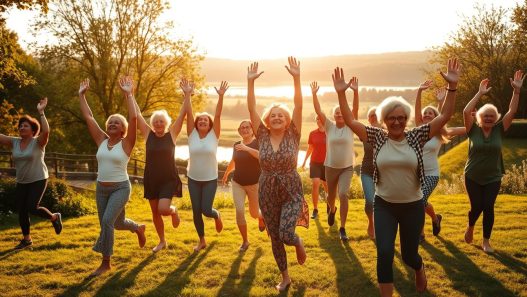Having a strong community around you can significantly impact your overall well-being. Being part of a group provides emotional support, reduces feelings of loneliness, and can even influence your health benefits. Studies have shown that people with robust social connections tend to have better health outcomes and live longer.
A sense of belonging to a community can boost your mental and physical health. It’s not just about having people around; it’s about feeling connected and supported. This connection can lead to a healthier lifestyle and increased longevity.
Key Takeaways
- Strong community ties improve overall well-being.
- Social connections reduce feelings of loneliness.
- Better health outcomes are linked to robust community support.
- A sense of belonging boosts mental and physical health.
- Feeling connected can lead to a healthier lifestyle.
The Science of Social Connection
Social connections play a vital role in our overall health, and research has begun to uncover the underlying mechanisms. The intricate web of relationships we weave throughout our lives has a profound impact on both our physical and mental well-being.
Research on Social Ties and Health Outcomes
Numerous studies have demonstrated a strong correlation between social ties and health outcomes. For instance, individuals with robust social connections tend to have lower blood pressure, healthier body mass indexes, and a reduced risk of chronic diseases. The quality of these relationships is also crucial, as supportive social networks can buffer against stress and anxiety.
The Biology of Belonging
The biology of belonging is rooted in our neuroendocrine system, which responds to social interactions by releasing hormones such as oxytocin and dopamine. These chemicals promote feelings of attachment and happiness, reinforcing the importance of social bonding for our well-being. Understanding this biological basis can help us appreciate why social isolation can have detrimental health effects.
Evolutionary Basis for Human Connection
From an evolutionary perspective, human connection has been essential for survival. Throughout history, humans have relied on group cohesion for protection, resource sharing, and care. This innate need for connection is deeply ingrained in our biology, underscoring the significance of maintaining strong social ties in modern life.
Social Connections and Longevity: Why Community Matters
The impact of social connections on our health and longevity cannot be overstated, with a growing body of evidence supporting the benefits of strong community ties. As we explore the relationship between social connections and longevity, it becomes clear that community plays a vital role in our overall well-being.
Blue Zones and Community-Centered Cultures
Research has identified areas around the world known as “Blue Zones,” where people live longer and healthier lives. These communities are characterized by strong social bonds and a sense of belonging. For example, in Okinawa, Japan, older adults are revered for their wisdom, and community gatherings are a regular occurrence. Similarly, in Sardinia, Italy, shepherds and farmers often work in close-knit groups, fostering a sense of camaraderie and shared purpose.
Statistical Evidence Linking Community to Lifespan
Studies have consistently shown that people with strong social connections tend to live longer than those who are isolated. A 2015 meta-analysis of 148 studies found that people with stronger social relationships had a 50% greater likelihood of survival over a given period. This effect is significant, as it translates into a substantial increase in lifespan for those with robust community ties.
- Social isolation can be as harmful as smoking 15 cigarettes a day.
- People with strong social connections have lower blood pressure and a reduced risk of cardiovascular disease.
- Community engagement is linked to a lower risk of dementia and cognitive decline.
The “Social Prescription” Movement in Healthcare
In response to the growing evidence linking social connections to health outcomes, some healthcare systems are beginning to adopt the concept of “social prescription.” This involves healthcare providers referring patients to community-based programs and activities that foster social connections. For example, a doctor might prescribe a patient a “dose” of volunteering or participation in a local club. This approach recognizes that social connections are not just a nicety, but a necessity for overall health and well-being.
By understanding the importance of social connections and community, we can take steps to strengthen our own social bonds and potentially increase our lifespan. Whether through joining local groups, volunteering, or simply making time for friends and family, investing in our social connections is an investment in our health and longevity.
Types of Community That Impact Health
Our health is impacted by a diverse range of community types, each contributing uniquely to our overall well-being. The various communities we engage with not only provide support but also influence our behaviors and health outcomes.
Family Connections
Family ties are among the most significant community connections. Supportive family relationships can enhance mental and physical health by providing emotional support and practical help. Research has shown that strong family bonds are associated with lower rates of depression and anxiety.
Friendships and Peer Groups
Friendships and peer groups offer a different kind of support, often based on shared experiences or interests. These relationships can provide a sense of belonging and are crucial for mental health. Socializing with friends can reduce stress and improve overall mood.
Neighborhood and Local Communities
The community we live in also plays a vital role in our health. Neighborhoods with parks, community centers, and local businesses encourage social interaction and physical activity. Living in a supportive neighborhood can enhance one’s sense of safety and community engagement.
Interest-Based and Faith Communities
Communities centered around shared interests or faith provide additional layers of support. These groups can offer a sense of purpose and belonging, contributing to overall well-being. Participation in faith communities, for example, has been linked to better health outcomes and longer life expectancy.
Physical Health Benefits of Strong Social Ties
Research has consistently demonstrated that individuals with strong social connections tend to have better physical health outcomes. This is due to several factors that contribute to overall well-being.
Cardiovascular Health Improvements
One of the significant physical health benefits of strong social ties is the improvement in cardiovascular health. This can be attributed to two main factors:
- Blood Pressure Regulation: Studies have shown that individuals with strong social support tend to have better blood pressure regulation, reducing the risk of hypertension.
- Heart Disease Risk Reduction: Socially connected individuals are less likely to develop heart disease, thanks to the stress-reducing effects of having a supportive community.
Immune System Function
A strong social network can also boost our immune system function. People with close social ties tend to have a more robust immune response, making them less susceptible to illnesses.
Recovery from Illness and Surgery
When we fall ill or undergo surgery, having a strong support system can significantly aid in the recovery process. Social connections provide emotional support, practical help, and encouragement, all of which are crucial for healing.
Healthy Behaviors and Accountability
Being part of a community encourages healthy behaviors and provides a sense of accountability. Whether it’s exercising together, sharing healthy meals, or supporting each other in quitting harmful habits, social connections promote a healthier lifestyle.

In conclusion, the physical health benefits of strong social ties are multifaceted, ranging from cardiovascular health improvements to a stronger immune system and faster recovery from illness. By fostering meaningful connections, we can significantly enhance our overall physical well-being.
Mental Health and Community Connection
Building strong community connections can significantly improve mental health outcomes. A robust community network provides emotional support, reduces feelings of loneliness, and enhances overall mental well-being.
Depression and Anxiety Reduction
Community connection plays a crucial role in reducing symptoms of depression and anxiety. Social support from community members can provide a sense of belonging and security, which is vital for individuals dealing with mental health issues.
Stress Management Through Social Support
Effective stress management is another significant benefit of community connection. By having a support system, individuals can better cope with stress, as they know they are not alone in facing life’s challenges.
Cognitive Benefits and Dementia Prevention
Engaging with the community can also have cognitive benefits, potentially reducing the risk of dementia. Mental stimulation and social interaction are key factors in maintaining cognitive health.
Sense of Purpose and Meaning
Being part of a community gives individuals a sense of purpose and meaning. This is particularly important for mental health, as it helps individuals feel valued and connected to something larger than themselves.
| Mental Health Aspect | Community Benefit |
|---|---|
| Depression and Anxiety | Reduced symptoms through social support |
| Stress Management | Better coping mechanisms through community |
| Cognitive Health | Reduced risk of dementia through mental stimulation |
| Sense of Purpose | Feeling valued and connected |
The Dangers of Social Isolation
The dangers of social isolation are multifaceted, impacting both mental and physical health. As we navigate the complexities of modern life, understanding the risks associated with social isolation is crucial.
Health Risks Comparable to Smoking
Research has highlighted that prolonged social isolation can have severe health implications, comparable to smoking 15 cigarettes a day. The lack of meaningful social connections can significantly increase the risk of premature mortality.
The Loneliness Epidemic in America
The United States is grappling with a loneliness epidemic, with far-reaching consequences on public health. A prominent health official once noted, “We are in the midst of a national epidemic of loneliness.”
“Loneliness and social isolation are critical public health issues, and addressing them requires a collective effort from communities, healthcare providers, and policymakers.”
Vulnerable Populations
Certain demographics are more susceptible to the adverse effects of social isolation. Understanding these vulnerabilities is key to addressing the issue effectively.
Elderly Americans
Older adults are particularly at risk due to factors such as the loss of a spouse, reduced mobility, and decreased social interaction. These changes can lead to a significant decline in their overall wellbeing.
Young Adults in the Digital Age
Interestingly, young adults are also experiencing high levels of loneliness, partly due to the superficial nature of online interactions. Despite being more connected than ever through technology, they are not immune to the effects of social isolation.

Building Meaningful Connections in Modern Life
In an era where superficial connections are increasingly common, cultivating genuine relationships requires effort and dedication. As we strive to build meaningful connections, it’s essential to understand the factors that contribute to their development.
Overcoming Barriers to Connection
Modern life presents several barriers to forming meaningful connections, including increased mobility, the rise of digital communication, and growing societal pressures. To overcome these barriers, individuals must be proactive in seeking out opportunities for connection.
- Join community groups or clubs that align with your interests.
- Participate in local events or volunteer opportunities.
- Make time for face-to-face interactions.
Quality vs. Quantity in Relationships
While having a large social network can be beneficial, it’s the quality of these relationships that truly matters. Focusing on a smaller number of meaningful connections can lead to greater overall satisfaction and support.
Investing in relationships that are mutually supportive and built on trust is crucial.
Creating Rituals and Traditions
Establishing rituals and traditions can strengthen bonds within a community or family. These shared practices create a sense of belonging and continuity.
- Regular family dinners or game nights.
- Annual community events or celebrations.
Vulnerability and Authentic Connection
Being vulnerable and open with others is a key component of forming deep, meaningful connections. It allows for authentic communication and fosters empathy.
By embracing vulnerability, individuals can build stronger, more resilient relationships.
Technology: Friend or Foe to Community?
As we navigate the digital age, the question of whether technology is a friend or foe to community building becomes increasingly relevant. The relationship between technology and community is complex, with both positive and negative impacts.
Social Media’s Double-Edged Sword
Social media platforms have revolutionized the way we connect with others. On one hand, they provide an unprecedented ability to stay in touch with friends and family across geographical distances. On the other hand, excessive social media use has been linked to increased feelings of loneliness and isolation. A study found that limiting social media use to 30 minutes per day can lead to significant improvements in mental health and well-being.
Key statistics on social media use:
| Platform | Average Daily Use | Impact on Mental Health |
|---|---|---|
| 30 minutes | Neutral | |
| 53 minutes | Negative | |
| 26 minutes | Positive |
Digital Tools for Building Real-World Connections
While social media has its drawbacks, digital tools can also facilitate real-world connections. Apps and websites dedicated to community building, such as Meetup.com, enable people to find and join local groups based on shared interests. These platforms can help bridge the gap between online interactions and in-person connections.
Finding Balance in a Connected World
Striking a balance between technology use and community engagement is crucial. By being mindful of how we use technology, we can harness its potential to enhance our communities rather than detract from them. This involves setting boundaries around our technology use and prioritizing face-to-face interactions.
Virtual Communities and Their Impact
Virtual communities have emerged as a significant aspect of modern community building. These online spaces allow people to connect with others who share similar interests or experiences, providing support and a sense of belonging. However, the impact of virtual communities on mental and emotional well-being can vary, depending on how they are used and integrated into one’s life.
In conclusion, technology is neither inherently a friend nor a foe to community; its impact depends on how it is used. By understanding the nuances of technology’s role in community building, we can work towards creating stronger, more resilient communities in the digital age.
Community Across Cultures and Generations
Community is experienced differently across various cultures and generations, reflecting diverse values and practices. The way people connect and form communities is influenced by their cultural background, age, and the societal context in which they live.
Cultural Differences in Social Connection
Cultural differences significantly impact how individuals form and maintain social connections. For instance, in collectivist cultures, community is often deeply ingrained in daily life, with family and community ties being paramount. In contrast, individualistic cultures may prioritize personal freedom and autonomy over community cohesion.
Collectivist vs. Individualistic Cultures: Understanding these cultural differences is crucial for building effective community strategies. Collectivist cultures, such as many Asian societies, emphasize the group’s needs over individual desires, fostering strong community bonds. On the other hand, individualistic cultures, common in many Western societies, focus on personal achievements and freedoms.
Intergenerational Communities
Intergenerational communities, where different age groups coexist and interact, offer numerous benefits. These communities can provide support, share knowledge, and foster a sense of belonging among members. They are particularly valuable in societies facing aging populations or where family structures are changing.
Benefits of Intergenerational Connections: Intergenerational communities can help bridge the gap between different age groups, promoting understanding and reducing age-related stereotypes. They also offer opportunities for younger generations to learn from the experiences of their elders.
Learning from Collectivist Societies
Collectivist societies offer valuable lessons in building strong, cohesive communities. By prioritizing the collective good, these societies demonstrate how community can be a source of strength and resilience. Strategies from collectivist cultures can be adapted to enhance community building in more individualistic societies.
- Emphasizing community over individual needs
- Fostering cooperation and mutual support
- Building strong social networks
Urban vs. Rural Community Dynamics
The dynamics of community can vary significantly between urban and rural settings. Urban areas often have diverse populations and a wider range of community activities, while rural areas may have closer-knit communities due to their smaller size and more limited social options.
Urban Community Challenges: Urban communities face unique challenges, such as higher costs of living, greater anonymity, and sometimes higher crime rates. However, they also offer opportunities for diverse social interactions and access to a wide range of community resources.
By understanding and appreciating these differences, we can work towards building stronger, more inclusive communities across cultures and generations.
Practical Steps to Strengthen Your Community Ties
Nurturing community connections is vital for a longer, healthier life. Strengthening community ties can be achieved through simple, consistent practices and by engaging with others in meaningful ways.
Starting Small: Daily Connection Practices
Daily connection practices can significantly impact our sense of community. Micro-interactions that matter include smiling at strangers, holding the door for others, or offering a kind word.
Micro-Interactions That Matter
Simple actions like greeting your neighbors or asking how someone’s day is going can foster a sense of belonging. These small gestures can brighten someone’s day and create a ripple effect of kindness.
Consistency Over Intensity
Consistency is key when it comes to building community ties. Regular, small interactions are more effective than occasional grand gestures. Making a habit of daily connections can lead to stronger, more meaningful relationships over time.
Finding Your Tribe: Community Groups and Organizations
Joining community groups or organizations that align with your interests is an excellent way to meet like-minded individuals and build connections. Whether it’s a hobby-based group, a volunteer organization, or a faith community, finding your tribe can enhance your sense of belonging.
Giving Back: The Health Benefits of Volunteering
Volunteering is not only beneficial for the community but also has significant health benefits for the individual. It can reduce stress, improve mental health, and even increase longevity. Volunteering is a practical way to give back while strengthening your community ties.
Creating Spaces for Connection
Creating spaces for connection, whether physical or virtual, is crucial for fostering community. This can be achieved by hosting gatherings, participating in local events, or creating online forums for discussion. By creating these spaces, we can facilitate meaningful interactions and build stronger community bonds.
Conclusion: Investing in Community for a Longer, Healthier Life
Investing in community is a vital step towards a longer, healthier life. The connections we make with others have a profound impact on both our physical and mental well-being. By understanding the importance of social ties and taking practical steps to strengthen our community bonds, we can reap the benefits of improved health outcomes and increased longevity.
As we’ve seen, community is not just a nicety, but a necessity for a healthy life. From the Blue Zones to local neighborhoods, the evidence is clear: strong social connections are key to a long and healthy life. By prioritizing community and making it a part of our daily lives, we can take control of our health and well-being.
So, what can you do today to start investing in your community? Start small by reaching out to a neighbor or joining a local group that aligns with your interests. Every connection counts, and the benefits will be worth it. By making community a priority, you’ll be taking a significant step towards a longer, healthier life.






